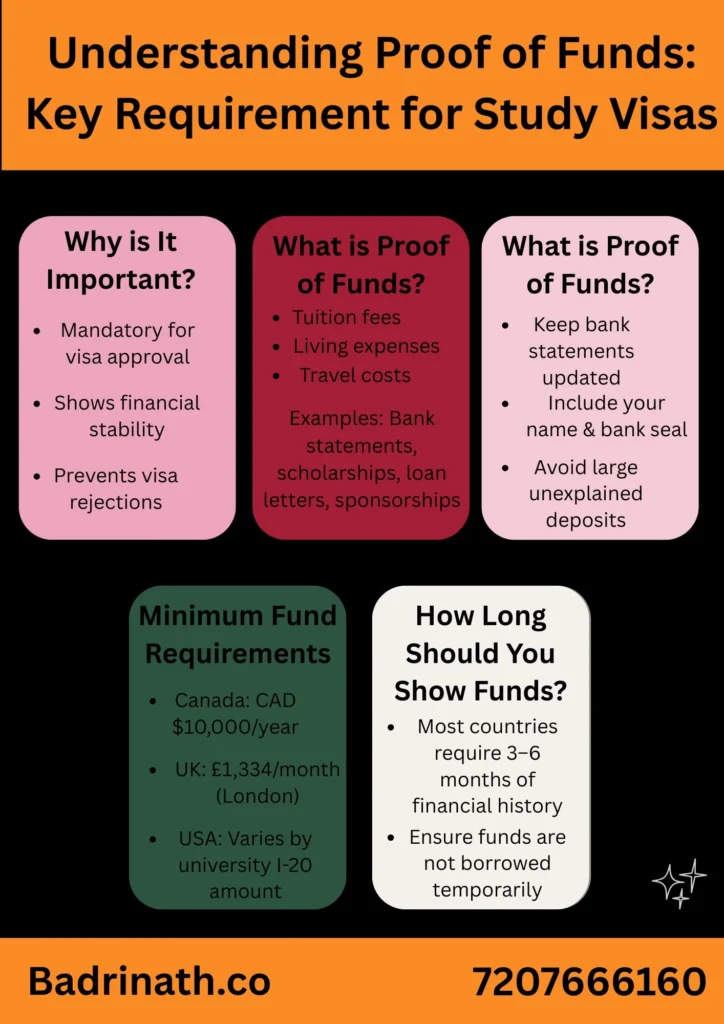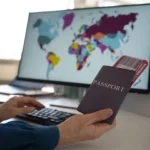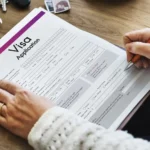When you’re dreaming of studying abroad, you usually picture top universities, cultural experiences, and career opportunities. But one key document can either move your application forward—or stop it in its tracks: Proof of Funds (POF). So, what exactly is Proof of Funds? In simple terms, it’s official documentation that shows you have enough money to support yourself while studying in a foreign country. It tells the visa officer: “Hey, I won’t be a financial burden on your system. I’ve got this covered.”

Why Do Countries Ask for Proof of Funds?
Countries like Canada, USA, UK, Australia, Germany, and many others require POF as part of the visa process. Why?
Because it ensures:
- You’re financially capable of paying for tuition fees.
- You can afford living expenses like rent, food, transport, and medical insurance.
- You won’t illegally work just to survive or drop out due to lack of funds.
This is crucial for governments to maintain immigration control, prevent misuse of visas, and ensure international students thrive academically.
Types of Study Visas That Require POF
Almost all study visas require it:
- Canada: Student visa (also known as study permit).
- UK: Tier 4 (General) student visa.
- USA: F-1 visa.
- Australia: Subclass 500 visa.
- Germany: Student visa and blocked account requirement.
Each of these has unique formats, documentation standards, and acceptable funding thresholds.
What Happens If You Don’t Provide POF?
Not submitting proper POF is one of the top reasons study visas get rejected. Even if you ace your SOP and have perfect academics, the visa officer will reject your application if you fail to show sufficient or verifiable funds.
Your application might get flagged if:
- The source of the funds isn’t clear.
- The documents appear outdated or forged.
- The amount is below the required threshold.
In some cases, you may be asked for further clarification. But often, it’s a straight denial.
Who Needs to Provide Proof of Funds?
Every international student must submit POF unless:
- You’re receiving a fully-funded scholarship.
- You’re part of a government exchange program.
- You’re eligible for a visa waiver program (which is rare and country-specific).
For everyone else, this is non-negotiable.
2. Acceptable Sources and Formats of Proof of Funds
Now that you understand the importance of Proof of Funds, let’s dive into what qualifies as acceptable POF and how you should format it.
What Qualifies as Acceptable POF?
Most immigration authorities accept:
- Bank Statements – The most common form of POF. Must be recent (usually within 3–6 months).
- Fixed Deposits (FDs) – Provided they’re liquid and can be broken easily.
- Education Loans – From recognized financial institutions.
- Scholarship Letters – Must clearly show full or partial coverage of tuition and/or living costs.
- Affidavits of Support – Legal documents where a family member or sponsor guarantees to support you financially.
- Provident Fund or Retirement Accounts – In certain cases and countries.
- Blocked Accounts – Like Germany’s €11,208 blocked account requirement.
- Sponsorship from Employers or Government – In some government-funded schemes.
How Much Money is Considered ‘Enough’?
It depends on the destination country. Here’s a rough idea:
- Canada: Tuition + CAD 20,635 per year (for one student outside Quebec).
- UK: Tuition + £1,334/month (London) or £1,023/month (outside London) for up to 9 months.
- USA: Tuition + estimated annual cost of living (~$10,000–$15,000).
- Australia: AUD 24,505/year + tuition.
- Germany: Minimum €11,208 in a blocked account.
Always check the latest guidelines from your chosen country’s immigration site.
Who Can Be Your Sponsor?
- Parents or immediate family members.
- Legal guardians.
- Educational institutions (via scholarships).
- Government bodies or international sponsors.
Friends or distant relatives are rarely accepted unless you prove close ties and financial relationships.
Format of Documents
When you submit POF:
- Use official letterhead (for bank or loan letters).
- Include account holder’s name, balance, date of issue, and bank seal.
- Translate documents if they’re not in English.
- Show currency conversion, if required.
- Keep documents neatly organized and include a table of contents.
How Recent Should the Documents Be?
Usually:
- Bank statements should not be older than 30-90 days.
- FDs should show maturity or breakable before arrival.
- Loan sanctions must be recent and active.
- Blocked account proof should include confirmation letter from the bank.
3. Mistakes to Avoid When Submitting Proof of Fund
This part is a lifesaver. Even if you technically have enough funds, mistakes in documentation can still cost you the visa.
1. Submitting Incomplete Documents
Let’s say your bank statement is for the right period, but it’s missing:
- The bank’s stamp
- Signature
- Holder’s name
Guess what? It’s not valid. Visa officers won’t request missing info—they’ll just reject.
2. Using Unacceptable Sources
Using cash in hand, borrowed funds from unverified sources, or property evaluations as POF? That’s a big no-no.
Some students try to show funds from friends or extended family with no legal or emotional ties. It doesn’t work.
3. Not Showing Liquid Funds
Many think “I have a house worth ₹1 crore, that should count.” But that’s not liquid. Visa officials need to see money that can be readily used, not assets that require selling.
Always focus on:
- Cash
- Bank balance
- Loan disbursement letters
- FDs and savings
4. Outdated or Forged Documents
A big red flag is when documents are:
- Dated months before submission
- Clearly manipulated or copied
- From non-credible banks
Visa departments now use AI and forensic tools to catch fraud. One strike = lifetime visa ban in some countries.
5. Mismatched Names or Currency Errors
If your POF is under a different name than your passport, explain the relationship (e.g., “Father’s account”). Use an affidavit of support.
Also, convert the local currency into the visa country’s currency and show the exchange rate.
6. Over-Reliance on Loans Without Proof of Disbursement
Many show approved loans but forget to show disbursement proof or bank confirmation. Visa officers need assurance the loan is ready and accessible—not hypothetical.

4. Best Practices to Prepare Strong Proof of Funds
Now that you know what not to do, let’s make sure your POF submission is bulletproof.
Start Early
Start preparing your financial documents at least 3–6 months in advance. This gives you time to:
- Move funds into the right accounts.
- Get official letters from banks.
- Sort out affidavits, translations, and notarizations.
Create a Clear Financial Summary
Include a cover letter with:
- Total tuition fees
- Estimated living cost
- Total available funds (from all sources)
- Source of funds breakdown (bank, FD, loan, scholarship)
- Currency conversion rate
- Explanation of relationship with the sponsor
This helps the visa officer understand your profile quickly and easily.
Use Recognized Banks and Institutions
Always choose:
- Nationalized or international banks
- Registered financial institutions (for loans)
- Government-affiliated scholarship boards
Using unverified banks can cast doubt on the authenticity of your finances.
Attach Supporting Documents
If you’re showing:
- Parents’ account: Add birth certificate and affidavit.
- Scholarship: Attach award letters, official correspondence.
- Loan: Include approval letter, terms, and disbursement proof.
Double-Check Everything
Before submission, verify:
- Names match across documents
- Dates are recent
- Totals are correct
- Bank seals are present
- Translation is notarized (if applicable)
Stay Transparent
If you’re relying on sponsors or multiple sources, mention that clearly. Honesty and clarity are appreciated more than inflated numbers.
Conclusion
Securing a study visa is a life-changing step, and Proof of Funds is one of the most non-negotiable parts of that journey. While it might seem like a simple document, it actually speaks volumes about your financial planning, responsibility, and preparedness. Remember, the visa officer doesn’t know you personally—they only see what you submit. So make it crystal clear that you’re ready to support yourself and focus on your education.
External Links
Proof of funds for study abroad explained






